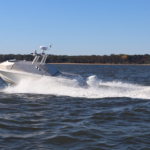
The Navy has developed a new Offensive Missile Strategy (OMS) to replace an older plan and focusing on sustaining relevant weapons, upgrading existing systems, and developing new strike missile capabilities. The Offensive Missile Strategy replaces the former Cruise Missile Strategy that outlined Department of Navy (DoN) plans to support cruise missile weapon systems and develop next generation weapons. The new strategy covers all non-nuclear offensive strike missiles with ranges over 50 nautical miles, according to written testimony provided to the…

 By
By 











